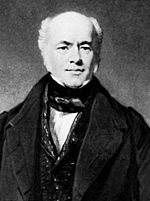Francis Baily facts for kids
Quick facts for kids
Francis Baily
|
|
|---|---|

Royal Astronomical Society portrait
|
|
| Born | 28 April 1774 Newbury, Berkshire, England
|
| Died | 30 August 1844 (aged 70) London, England
|
| Resting place | St Mary's Church in Thatcham |
| Known for | Baily's beads President of the Royal Astronomical Society |
| Awards | Gold Medal of the Royal Astronomical Society (1827 & 1843) |
| Scientific career | |
| Fields | Astronomy |
Francis Baily (born April 28, 1774 – died August 30, 1844) was an English astronomer. He is best known for discovering "Baily's beads". These are bright spots seen during a solar eclipse. Francis Baily also helped start the Royal Astronomical Society. He was even its president four times!
Contents
Early Life and Career
Francis Baily was born in Newbury, Berkshire in 1774. His father was Richard Baily. When he was young, Francis traveled to North America. He explored the wilder parts of the continent between 1796 and 1797.
After his travels, Baily started working at the London Stock Exchange in 1799. He became very good at writing about money and investments. He wrote books like Tables for the Purchasing and Renewing of Leases (1802). He also wrote The Doctrine of Interest and Annuities (1808). His book The Doctrine of Life-Annuities and Assurances (1810) was also very famous.
Baily worked hard and honestly. He earned a lot of money from his business. In 1825, he decided to retire from his work. He wanted to spend all his time studying astronomy.
Contributions to Astronomy
Francis Baily played a big part in creating the Royal Astronomical Society in 1820. This is a very important group for astronomers. He won the Gold Medal of the Royal Astronomical Society twice. He received it first in 1827 for making a list of 2,881 stars. He won it again in 1843.
Baily was elected as the President of the Royal Astronomical Society four times. Each time he served for two years. This means he was president for a total of eight years. No one else has been president for longer than him!
Improving Star Catalogues
Baily worked hard to improve how stars were listed. He helped change the Nautical Almanac in 1829. This book helps sailors find their way using the stars.
In 1837, he helped organize and complete a huge project. This project involved listing about 57,000 stars from older lists. He also oversaw the creation of the British Association's Catalogue of 8377 stars. This important list was published in 1845. He also checked and updated older star lists by famous astronomers. These included Ptolemy, Tycho Brahe, and Edmund Halley.
Baily's Beads and Eclipses
Francis Baily is most famous for observing "Baily's beads". He saw them during an annular eclipse of the Sun on May 15, 1836. He was in Scotland at the time.
Baily described this event so well that it made many people interested in solar eclipses. Baily's beads are bright spots of sunlight. They shine through the valleys and gaps on the Moon's edge. This happens just before and after a total solar eclipse.
His description led to many people watching the total eclipse on July 8, 1842. Baily himself watched this eclipse from Pavia, Italy.
Measuring the Earth
Baily also did other important scientific work. He finished experiments about the Earth's shape. From these, he figured out that the Earth is slightly flattened at its poles.
He also worked on finding the average density of the Earth. This means how heavy the Earth is for its size. He used a method first developed by Henry Cavendish. Baily's careful work between 1838 and 1842 gave a very accurate value for the Earth's density.
Later Life and Legacy
Francis Baily passed away in London on August 30, 1844. He was buried in his family's tomb at St Mary's Church, Thatcham.
His book about John Flamsteed (published in 1835) is very important. Flamsteed was England's first Royal Astronomer. Baily's book helped us understand the history of astronomy better.
Many things are named after Francis Baily to honor him:
- The Baily crater on the Moon.
- Baily's metal, which is a special alloy. It was used to make a standard measurement tool in 1855.
- A primary school in Thatcham, his hometown, is called Francis Baily CofE Primary School.
See also
 In Spanish: Francis Baily para niños
In Spanish: Francis Baily para niños



